Biarritz Sea Museum
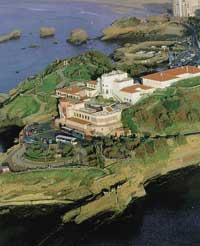
The world of oceanography can be said quite new, the XIX. Scientists began researching the oceans and the bottom of the oceans in the second half of the 20th century. From 1864 to 1896 Marquis Folin worked intensely in oceanography throughout Europe, being one of the pioneers in this field. In 1883, Marquis Folin collaborated in the foundation of the Biarritz Association and at the inauguration he pronounced the following words: “It is necessary that Biarritz recognize this particular situation, creating a learning space where people come from all over the world.” From this idea was born the Sea Museum and later the Center for Scientific Studies and Research.
They spent several years until the construction of the museum in August 1933. The collections were gradually arriving and finally, under the direction of Paul Arné, it was officially extended on 7 July 1935. It was considered by the architects of the time as a very modern construction, with fairly innovative exhibition rooms.
Restoring the museum

In the 1980s the obsolescence of some constructive sections was discovered. According to technical studies, it was necessary to renew the exhibitions. The works began in October 1991, after the approval of a laborious restoration project. After eight months, the new museum opened in the summer of 1992, maintaining in any case the initial spirit.
With the renovation the rooms were improved, applying the current techniques for the enjoyment of visitors: air conditioners, anti-steam systems in aquarium crystals, improvement of phonic isolation, etc. They have sought the balance between the spirit of the old building and current museum presentations.
With the renovation of the Museum, the objectives to be achieved by this space were also clearly set: visitors are wanted to enjoy understanding, discovering and learning, first with the visit, taking care of the aesthetic vision of the visit and through the illustrations (photographs, images, models and objects); second, through games, with interactive audiovisual systems, resting spaces and the L´Atalaya bar facing the sea; and contact with the living organism of Christianity.
Gulf of Bizkaia on three floors
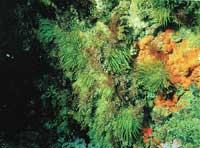
The duration of the visit usually varies between an hour and a half and three hours and so we did. We start with the main hall of the new aquariums of the ground floor. It is an ideal place to know the fauna and flora of the Bay of Biscay, which allows to know the underwater diversity, offering different shapes, decorations and visions. The interior decoration of each aquarium, large or small, is of great quality and authenticity thanks to the use of natural stones. All this in order for the visitor to really feel the underwater environment. On this ground floor you can see the mold of the peculiar tortoise Carey.
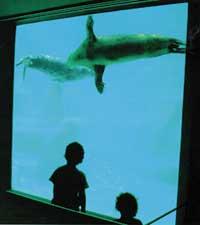
The seal or seal aquarium between the second floor and the terrace is exceptional. It is a 150 m3 volume aquarium that is cleaned monthly and filled with 150 thousand liters more water. Only in this aquarium chlorine is used to prevent the formation of harmful microscopic algae. A special system controls chlorine so that animals are comfortable and have no health problems. It is forbidden to bring dogs to the museum, as they can infect seals with the serious Carré disease.
On the first floor you can see different rooms, conveniently illustrated, with special attention to diving, fishing and oceanography. In the Folin room, for example, we are offered explanatory information on the history and evolution of oceanography. We analyze whale fishing in the adjoining room, explaining other fishing techniques. In this plant, however, the skeletons and molds of cetaceans are the most striking (the celacanthus fossil is mandatory).

The sculpture of the laud turtle is hung on the stairs leading to the second floor. This well-known turtle was captured on the island of Oleron in 1936 and took five days to take it to Biarritz. It was placed in a large tank, but only survived two days.
Four temporary exhibitions per year
Temporary exhibitions are installed in the Arné room on the second floor, each with a minimum duration of three months. Normally three of these four are scientists and the fourth is artistic.
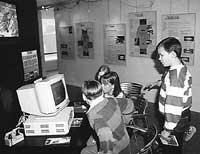
In addition, it is a single exhibition made by the museum itself (it must be borne in mind that to prepare a work of this type it takes about five months); the other three are brought from outside. All of them are related to the sea and must be of small volume to be able to move from one museum to another. The exhibitions on freshwater and the islands of the Kergüelen of Antarctica are already assembled and exhibited works by the Navarrese artist Goiko, and the last exhibition of the year will analyze the influence of astronomy on the sea and on dry land.
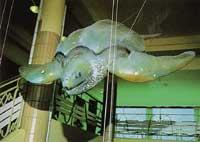
On the other hand, on the same floor is the audiovisual room of Atalaya. Objects and tables let us know more about geology, meteorology and oceans. One of the first surfboards in history is in a showcase: This old board weighs 22 kilos! Our eyes, however, will probably go to the seals, as through a large glass we can see these mammals in the subsoil with total tranquility. More than one visitor will finally be surprised to see the ferment of sharks (behind a crystal, clear).

The seals mentioned above can be seen on the upper terrace coming out of the water. There is the possibility of lounging facing the sea in the quiet bar next door, as well as acquiring some detail or souvenir in the shop. You cannot finish the visit without passing through the ornithological gallery. The birds that can be seen in Euskal Herria are presented through the collection of 270 dissected species. There is also an original presentation for the little ones and also for the older ones: Possibility to listen to songs of 40 birds in the small room.
Without forgetting research
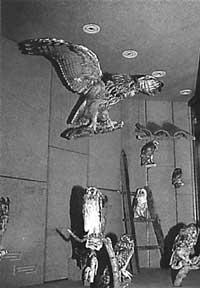
The Biarritz Research and Studies Centre (CERS), related to the Museum, was founded in 1956 and has since done important work with the following laboratories:
- Fisheries Institute Laboratory (ISTPM)
- Laboratory of the Institute of Agricultural Research (INRA)
- Water Analysis Laboratory (CEDA)
- Plankton and Microfauna Laboratory (LAPHY)
- Institute of Stewardship (IRSID)
- Water Environment Institute (IMA)
- Laboratory of the National Museum of Paris.
Local scientists also work with other public aquariums from different countries, exchanging information and experiences.
At this time the coast is being investigated from the beach of Port-vieux to the rock of the virgin, especially the native fauna. Noteworthy is the fauna richness of this area, with numerous rocks and deep holes. But some species of fish gradually disappear. To carry out this research, scientists have contacted fishermen from San Juan de Luz, among others.
Looking ahead
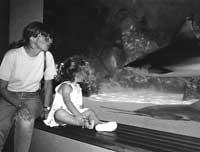
In total there are twenty people working in the museum, but of them scientists, who are dedicated to research, are Laurent Soulier and M. They are Harambillet. When asking about future projects, Laurent Soulier has shown us his desire to work:
“On the one hand, we would like to create a pedagogical center, as it is an important step forward. On the other hand, the collaboration with people dedicated to astronomy and underwater fishing is very positive; we also intend to develop scientific projects with the University of Baiona; we will also collaborate with the Acuarium of San Sebastian; and we are working on the development of a guide in different languages to provide more information”.
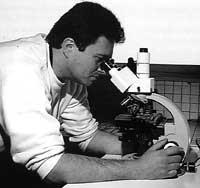
The Biarritz Sea Museum is therefore modern and attractive. The most significant data is the number of visitors: If in the first years there were between 30,000 and 50,000 visitors a year, in the decade of the 50 passed to exceed 100,000 visitors, while from 1972 they remained for some years in 170.000 people. The works were carried out in autumn 1991 and by then the museum was visited by 6.7 million people. The renovation has meant an increase in the number of visitors and in 1996 270,000 people were at the Museo del Mar. The success of this beautiful museum is evident.
The museum is open every day of the year except the second week of January. HOURS In summer it changes schedule. Phone numbers: Fax: |





